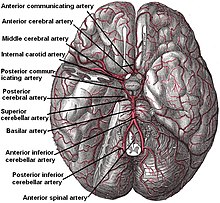
Back نقص التأكسج الدماغي Arabic Hypoxie (Medizin)#Zerebrale Hypoxie German Hipoxia cerebral Spanish Garuneko hipoxia Basque Hypoxie cérébrale French Anossia cerebrale Italian 低酸素脳症 Japanese ମସ୍ତିଷ୍କ ସ୍ୱଳ୍ପଅମ୍ଳଜାନ OR Hipóxia cerebral Portuguese 腦缺氧 Chinese
| Cerebral hypoxia | |
|---|---|
 | |
| Circle of Willis Arteries beneath brain | |
| Specialty | Critical care medicine |
Cerebral hypoxia is a form of hypoxia (reduced supply of oxygen), specifically involving the brain; when the brain is completely deprived of oxygen, it is called cerebral anoxia. There are four categories of cerebral hypoxia; they are, in order of increasing severity: diffuse cerebral hypoxia (DCH), focal cerebral ischemia, cerebral infarction, and global cerebral ischemia. Prolonged hypoxia induces neuronal cell death via apoptosis, resulting in a hypoxic brain injury.[1][2]
Cases of total oxygen deprivation are termed "anoxia", which can be hypoxic in origin (reduced oxygen availability) or ischemic in origin (oxygen deprivation due to a disruption in blood flow). Brain injury as a result of oxygen deprivation either due to hypoxic or anoxic mechanisms are generally termed hypoxic/anoxic injuries (HAI). Hypoxic ischemic encephalopathy (HIE) is a condition that occurs when the entire brain is deprived of an adequate oxygen supply, but the deprivation is not total. While HIE is associated in most cases with oxygen deprivation in the neonate due to birth asphyxia, it can occur in all age groups, and is often a complication of cardiac arrest.[3][4][5]
- ^ Malhotra R, et al. (Nov 2001). "Hypoxia induces apoptosis via two independent pathways in Jurkat cells: differential regulation by glucose". American Journal of Physiology. Cell Physiology. 281 (5): C1596–C1603. doi:10.1152/ajpcell.2001.281.5.c1596. PMID 11600423. S2CID 10558756.
- ^ Mattiesen W. R.; et al. (May 2009). "Increased neurogenesis after hypoxic-ischemic encephalopathy in humans is age related". Acta Neuropathol. 117 (5): 525–534. doi:10.1007/s00401-009-0509-0. PMID 19277687.
- ^ Robinson, LR; Micklesen, PJ; Tirschwell, DL; Lew, HL (Mar 2003). "Predictive value of somatosensory evoked potentials for awakening from coma". Critical Care Medicine. 31 (3): 960–967. doi:10.1097/01.ccm.0000053643.21751.3b. PMID 12627012. S2CID 18080596.
- ^ Geraghty M. C.; Torbey M. T. (2006). "Neuroimaging and serologic markers of neurologic injury after cardiac arrest". Neurol Clin. 24 (1): 107–121. doi:10.1016/j.ncl.2005.10.006. PMID 16443133.
- ^ Busl K. M.; Greer D. M. (Jan 2010). "Hypoxic-ischemic brain injury: pathophysiology, neuropathology and mechanisms". NeuroRehabilitation. 26 (1): 5–13. doi:10.3233/NRE-2010-0531. PMID 20130351.
© MMXXIII Rich X Search. We shall prevail. All rights reserved. Rich X Search